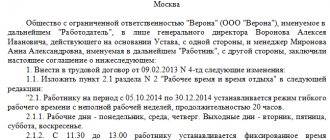What it is
To accurately calculate the hourly tariff rate in 2020, you need to consider:
- employee's monthly salary;
- type of workweek (5-day or 6-day, 40-, 36- or 24-hour);
- number of working hours in 2021
For reference, the most common type of workweek is 5 days, 8 hours a day. Teachers, service workers, and some other categories work 6 days a week, but their total working time per week will be 40 hours (usually their work schedule in hours is as follows: 7 + 7 + 7 + 7 + 7 + 5 = 40).
Regarding the duration of a 5-day work week:
- Adolescents under 16 years of age and employees of production facilities producing chemical weapons should work no more than 24 hours a week;
- no more than 36 hours a week - teachers, workers in industries with harmful and dangerous working conditions, etc.
Medical workers, depending on their position and specialty, have a 24-, 30-, 33-, and 36-hour work week.
Tariff rate
According to Art. 129 of the Labor Code of the Russian Federation, the tariff rate is a fixed amount of remuneration for performing certain work during a unit of time, without taking into account compensation, incentives and social payments to the employee. Tariff rates can be calculated per month, day, or hour.
The monthly tariff rate (or salary) does not depend on the number of working days or hours in a particular month - the salary is always calculated in the amount of the salary if all working days of the month are fully worked. Moreover, it does not matter that there may be more working days in one month than in another, this does not affect the amount of earnings.
The daily tariff rate is applied if the length of the working day is always the same, but the number of working days in a month differs from the established norms.
An hourly rate may be needed when calculating payment for hours worked is required, namely:
- to calculate earnings with a shift work schedule and summarized recording of working hours,
- to calculate wages for overtime work,
- for pay for night work,
- to calculate wages on weekends and holidays,
- to pay for work in harmful and dangerous conditions.
How to calculate
Let's consider 2 calculation options: for 40 and 24 hours of work per week. To calculate the hourly tariff rate from the hourly salary, the formula is used:
Example 1: 40 hours per week.
Let’s say a proofreader at a publishing house works 5 days a week, 8 hours a day.
Salary - 20,000 rubles per month.
The number of working hours in 2021 at 40 working hours per week is 1970.
Hourly tariff formula: 20,000 × 12 /1970 = 121.82 rubles.
Example 2. 24 hours a week.
A 15-year-old teenager works as a courier for a publishing house.
Salary - 15,000 rubles per month.
The number of working hours in 2021 with a 24-hour work week is 1179.6.
Formula for calculating the hourly tariff rate for 2021: 15,000 × 12 / 1179.6 = 152.5 rubles.
Average earnings calculator
This is a time period, the beginning of which is the moment the property is put up for sale, and the end is the moment the transaction is completed. However, the exposure period is not the exclusive calculation criterion.
Important
There are two main methods for calculating liquidation value: direct and indirect. 3. With the direct method of calculation, a comparison of the object put up for sale with a similar object sold earlier is used.
This method is primitive, but not always applicable, due to the fact that information about liquidated objects is rarely available on the real market. 4. The indirect method of calculating liquidation value involves calculation through market value.
This method is carried out in three steps: determining the market value of the object, calculating the discount for the forced sale, calculating the liquidation value.
Minimum size
The legislation does not establish a minimum hourly wage rate in 2021. But when calculating it, it is necessary to take into account the following: the minimum monthly salary of an employee who has worked the full working time cannot be lower than the minimum wage. From January 1, 2019, the federal minimum wage is 11,280 rubles. It is obvious that the hourly wage rates of workers for 2021 will not be lower than those calculated from the minimum wage.
The hourly tariff rate from the minimum wage for a 40-hour work week is calculated using the formula:
If a regional minimum wage has been established in the region where the organization operates, the company should focus on it. For example, in Moscow the minimum wage is 20,195 rubles, and in St. Petersburg - 18,000 rubles.
Average earnings calculator
It depends on what you compare it to.
If you think that a similar person in the office “will go to work for twenty,” then you are very mistaken. An office employee with similar experience and knowledge will want at least 40-50 thousand rubles per month, plus add all salary taxes on top. Plus, you will have to provide an office employee with a workplace, provide vacation, pay sick leave, somehow motivate, and no one will come to you for a one-time project. Because a full-time employee needs permanent work, not temporary employment.
For a freelancer with a rate of 700 rubles per hour, firstly, work takes far from 160 hours a month. It takes a lot of time to find clients, communicate in the process of selling a service, and there are downtimes. In reality, such a specialist will pocket 70-80 thousand rubles a month, and in the best case – about 100 thousand rubles (overworked). Not the biggest money even by small business standards.
How to calculate overtime
Calculating the hourly tariff rate is necessary to correctly pay the employee for overtime hours. According to the Labor Code, for the first 2 hours the rate per hour of work is multiplied by 1.5, for subsequent hours - by 2.
Example 3.
An urgent job arose that cannot be “postponed until tomorrow,” and the proofreader worked 11 hours instead of 8. Then he will be paid for 3 hours (using the average hourly wage rate in 2021 from Example 1):
121.82 (hours) × 2 (first 2 hours of processing) × 1.5 (increasing factor) + 121.82 (hours) × 1 (third hour of processing) × 2 (increasing factor) = 609 ,1 ruble.
IMPORTANT!
Teenagers under 18 years of age cannot be involved in overtime work, so we will not provide formulas for courier workers.
Hourly wages - what is it, how to calculate
- The company's remuneration system is established by collective agreements, industry and regional agreements, local regulations, regulations, in accordance with labor law standards.
- The division of remuneration systems into subtypes is quite arbitrary. Typically, there are several forms of remuneration systems:
- Time-based – an employee’s salary depends directly on the time worked. The fixed tariff rate can be hourly, daily or monthly;
- Piecework – an employee’s salary depends on the amount of work he performed;
- Commission is a remuneration system in which the employee receives a commission (percentage) on a fixed indicator. For example, 10% of the outlet’s revenue per day;
- A variable salary system is a system in which an employee's salary can change periodically - for example, once a quarter or once a month. Changes may depend on the implementation of the work plan or other indicators;
- Lump-sum – when using such a remuneration system, the employee’s salary will depend on the set of works he performs (in accordance with the lump-sum task) for a certain period of time.
Example of payroll calculation in 2021
What is taken into account when calculating?
Today, two types of fees are most often practiced:
- Time-based . The first provides for a salary determined by the contract for the time worked - hour, day, month. Often a monthly rate is used. In this case, the final amount depends on the time worked during a certain period of time. It is used mainly when calculating salaries for employees on whom the amount of product created does not depend - accountants, teachers, managers.
- Piecework . Depends on the amount of product created over a certain period. Often used in factories. It has several subspecies, which we will consider a little later.
Thus, time-based wages stipulate that the head of the enterprise or other official is required to maintain and fill out a time sheet. It is drawn up according to form No. T-13 and is filled out daily.
It should note:
- number of working hours worked during the day;
- exits “at night” – from 22:00 to 6:00;
- out during non-working hours (weekends, holidays);
- omissions due to various circumstances.
Piece payment requires the availability of a route map or work order for a certain amount of work. In addition, the following are taken into account: sick leave, orders for bonuses, orders for the issuance of financial assistance.
After being hired, each accountant must keep analytical records of wages and record it in form No. T-54. This is the so-called employee personal account. The data specified in it will be taken into account when calculating sick pay, vacation pay and other types of benefits.
You can find out how vacation pay is calculated from this article.
The Labor Code of the Russian Federation provides for a minimum monthly salary of 5,965 rubles. The employer has no right to set payment below this amount. For more information on this topic, read the article - What is the minimum wage in Russia.
How does the regional coefficient affect wages?
Sometimes you need to know how to calculate salary in conditions where, due to difficult climatic conditions, increased radiation or other harmful factors, an additional factor “for harmfulness” is added to the employee’s salary.
This coefficient is also called regional, but it should not be confused with northern allowances for residents of the Far North. A similar coefficient is used in Udmurtia, Bashkortostan, Perm, Chelyabinsk, Vologda, Kurgan and other regions.
The size of the coefficient is established by the Government of the Russian Federation separately for each region.
Example:
Still the same citizen N, with a salary of 38,000 rubles. and a bonus of 15%, worked all the days in good faith, does not have a tax benefit. The coefficient for the region where our citizen N lives is 1.8. It should be used like this:
- 38,000 + 5,700 = 43,700 - salary + bonus;
- 43,700 x 1.8 = 78,660 - salary taking into account the coefficient;
- 78,660 - 13% = 68,434.2 rubles. - salary to payoff.
Calculation formula and examples
Time-based wages provide for payment of labor according to the time worked and the employee’s salary.
It is calculated as follows:
For monthly salary:
- ZP=O*CODE/KD, where
- ZP – salary excluding taxes;
- О – fixed salary per month;
- KOD – days worked;
- KD – number of days in a month.
For hourly/daily fixed salary:
ZP=KOV*O, where
- ZP – salary excluding taxes;
- KOV – amount of time worked;
- O – salary for one unit of time.
Let's look at an example:
Tatyana Ivanovna has a monthly salary of 15,000 rubles. There were 21 working days in a month, but since she took vacation at her own expense, she worked only 15 days. In this regard, she will be paid the following amount:
15,000*(15/21)=15,000*0.71= 10,714 rubles 30 kopecks.
Second example:
Oksana Viktorovna works with a daily salary of 670 rubles. She worked 19 days this month. Her salary will be:
670*19 = 12,730 rubles.
As you can see, the formula for calculating wages for this type of payment is very simple.
Should you trust the salary calculated by the accounting department?
The management of the enterprise is obliged to inform hired specialists about all accruals and deductions made that affect the amount issued in hand. The procedure for calculating wages is usually reflected in special sheets - “calculations” provided to staff.
To understand how much you are entitled to for the month you worked, ask your accountant for data, familiarize yourself with the algorithm and study an example of payroll calculation. Keep an eye out for factors that influence your final pay and plug the numbers into the formula.
Compare two results: yours and the employer's. If there is a discrepancy, ask your accountant to walk you through each step of the calculation. He will explain to you how the amounts were calculated, and it will become clear who made the mistake and whether the employee’s doubts are groundless.










